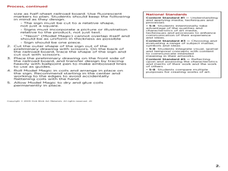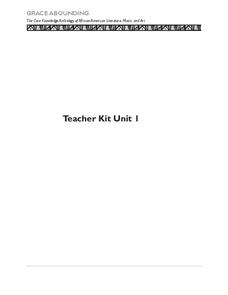Curated OER
CONTAMINANT SCAVENGER HUNT
Pupils identify substances and activities within a household that contribute to water pollution and identify safe cleaning alternatives for commercial cleaning products.
Curated OER
Neon Signs
Middle schoolers study a commercial art form and explore its historic and social meaning. They apply linear color to a shape, bending and forming the lines in much the same way a sign artist would form glass tubing. They design their own...
Curated OER
Create a Commercial
Pupils apply their knowledge of the persuasive appeals by creating a commercial which uses one or more of the three appeals (logos, pathos, and ethos) in order to persuade. They also differentiate among the three appeals as used in their...
Curated OER
Puppy Poop Pouch
Students create a device to hold dog poop to help keep trails clean. In this animal care lesson, students utilize donated fabric to create a couple hundred pouches to help people clean up after their dog. Students spread awareness of...
Curated OER
Smogasbord
When your environmental or earth science class is studying air pollution, you will want to take the time to go over this resource. Pupils peruse the history of air pollution regulations and examine outstanding diagrams of what...
Curated OER
Laundromat Skills
The worst part of the week is trying to scrounge quarters for the laundromat. Make the task of cleaning laundry an easy one for your high-functioning special needs learners. You take a trip to a local laundromat to practice using coin...
Curated OER
The Renaissance
Get out a clean sheet of paper and get ready to take notes on the Italian Renaissance. Kids can easily follow along as you progress through each informative slide. They'll take notes on humanism, classical learning, city-states, and...
Curated OER
Teacher Kit Unit 1
Nine lessons makeup a unit designed to reinforce grammar and vocabulary through practice pages based on readings of African folktales. Each lesson consists of a mini lesson, a vocabulary review, and a worksheet. Topics include...
Curated OER
Groundwater: Cleaning Up
Students research the various aspects of groundwater contamination that threaten health and human safety. They create a model and display that informs other about the health and safety risks. Students illustrate ways in which these...
Curated OER
Got Water?
Students determine that delivering clean, fresh water to citizens around the world involves and affects politics, economics, international relations, and technology. They brainstorm a list of factors that might affect their town's...
Curated OER
Natural Cleaners
Students explore natural cleaners. In this science lesson plan, students gain an understanding of the effects that commercial cleaners have on the environment and teach them to make their own cleaners out of less hazardous materials.
Curated OER
Eraser Carving
Middle schoolers get involved in rubber stamping. They comprehend that rubber stamps have been in use for a long time for commercial purposes and in crafts. Students find they are easy to print and provide a quick way to make multiple...
Curated OER
Where Should It Go? Recycle? Compost? Incinerate? Landfill?
Students discuss what happens to trash after it is collected. They sort "clean" trash into groups depending on whether it should be recycled, incinerated, placed in a landfill, composted or if it is something we could avoid using.
Curated OER
Exploiting Antarctica
Students read the story and diary "Lizzie's diaries from Antarctica and Antarctica" to get massive clean-up. Students discuss their knowledge of life in Antarctica and raise the fact of the Amundsen-Scott South Pole Station and its...
Curated OER
For Creative Minds
Students study pictures of plants, animals, and minerals. Students classify the pictures into the three groups. For this rock identification lesson, students complete a rock finding lab experiment by finding, cleaning, identifying, and...
Curated OER
Marine & Aquatic Habitats -- Journey of a Drop of Water Through a Watershed
Students discuss pollution and the steps in the hydrologic cycle. They follow a drop of water through a watershed simulation. They discover the components of a water cleaning system as well.
Curated OER
A River Ran Wild
Students describe and illustrate pollution and how to clean up pollution. They display their solutions by creating posters, signs, bumper stickers, slogans, T-shirt designs, commercials and poetry. This instructional activity ties in...
Curated OER
Keep America Beautiful: Thinking Green in the Classroom
Stress the importance of community involvement to preserve the beauty of our Earth with these great ideas.
Curated OER
What Is Special About Polyethylene Food Storage Bags?
Students participate in an investigation in which they compare a polyethylene bag designed for recycling or disposal with a polyethylene food storage bag. Students use hexane to determine the differences between the low density...
Curated OER
Growing from Seed
High school or college horticulturists will appreciate this PowerPoint on seed-propagation. It walks them through the science behind seed production and germination as well as the requirements for growing plants from this stage....
Clean Up Australia
Why are Batteries Harmful to the Environment?
Open this lesson by reading together about primary and secondary batteries (such as nickel-cadmium cells), problems they can cause in the environment, and how humans can minimize the damage. Afterward, little ones examine a collection of...
Curated OER
Connecting the Dots: Workers and Their Importance
Students explore the role of workers and their jobs in the community. They write a friendly letter to a community worker expressing appreciation for the work they do and their importance to the community.
Curated OER
Prepositions Can Show Positions in Time
Who knows where or when? The preposition knows! Young grammarians are asked to identify the preposition and the connecting prepositional phrases in 16 sentences. An answer key is provided.
Curated OER
Bird Seed Mining
Learners search through the seed mixture and separate out our "mine" beads, sunflower seeds, and other grain products, making piles of each. students count up the number of gold, silver, and blue beads, and sunflower seeds from their piles

























